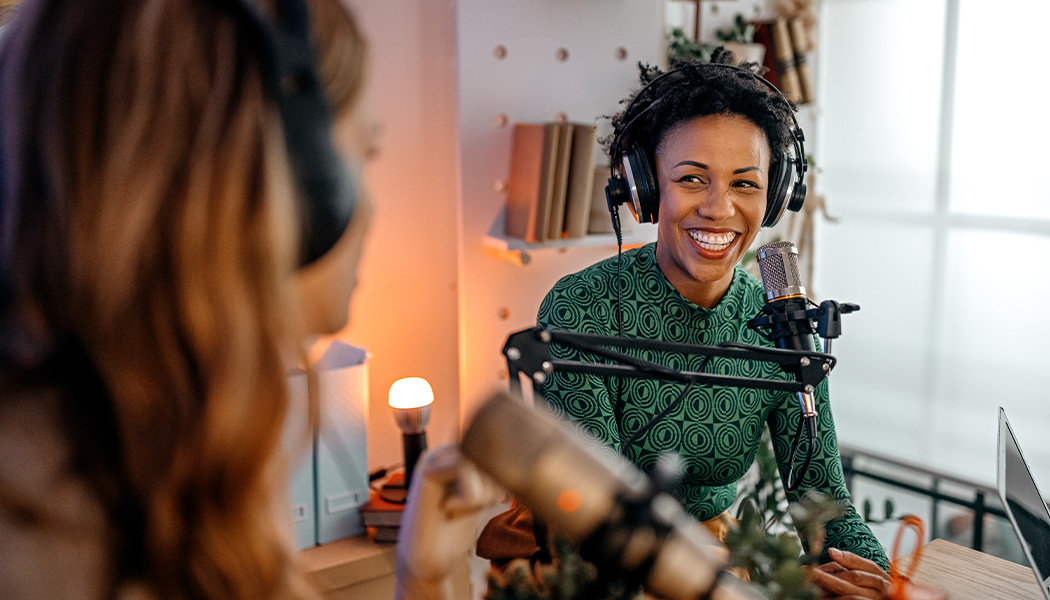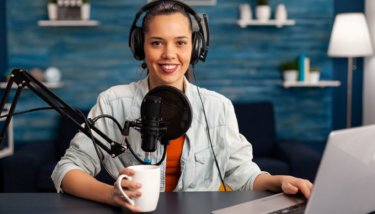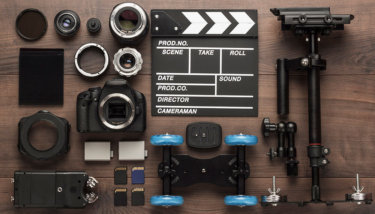Podcasts are great, right? You can listen to them while driving, working out, and even while washing the dishes to make boring tasks a little more fun.
But if you’re a podcaster looking to engage with your audience even more, video podcasting is the way to go.
Video podcasting is a positive spin on the phrase: “Killing 2 birds with one stone.” Instead, it’s more like: “Feeding hundreds of birds with one feeder.”
Here’s why: You’ll be creating one podcast for different kinds of consumers; some prefer to listen to you, and some prefer to watch you. So what’s better than putting them together as one?
Since some of the most popular podcast platforms allow video and a lot of podcasters are sharing their podcasts on YouTube, it’s time to consider adding video podcasting to your content strategy.
That’s where this guide comes in as your source on all things video podcasting, from the benefits it can have for content creators to the tips to get started and be successful.
Let’s get rolling!
What Is a Video Podcast?
A video podcast is a regular podcast but with a video recording element added to it.
Are you asking yourself: Is a video podcast still a podcast? It sure is! A video podcast brings the same benefits as a regular podcast but adds a visual element, even if super simple.
The video element of a podcast can be a static image, pre-recorded footage, or a video recording of you and your guests talking.
Sure, podcasts began as audio-only formats. Through the years they’ve evolved to include visual elements to make content more engaging with the context of facial expressions, body language, and other emotions.
Video Podcasting vs Audio Podcasting
An audio podcast is a program that can be listened to and is usually in the form of episodes. They work similarly to listening to a radio show, where people talk about topics, host interviews, or tell stories.
A video podcast is essentially the same thing, but the creator adds a video element to complement the audio.
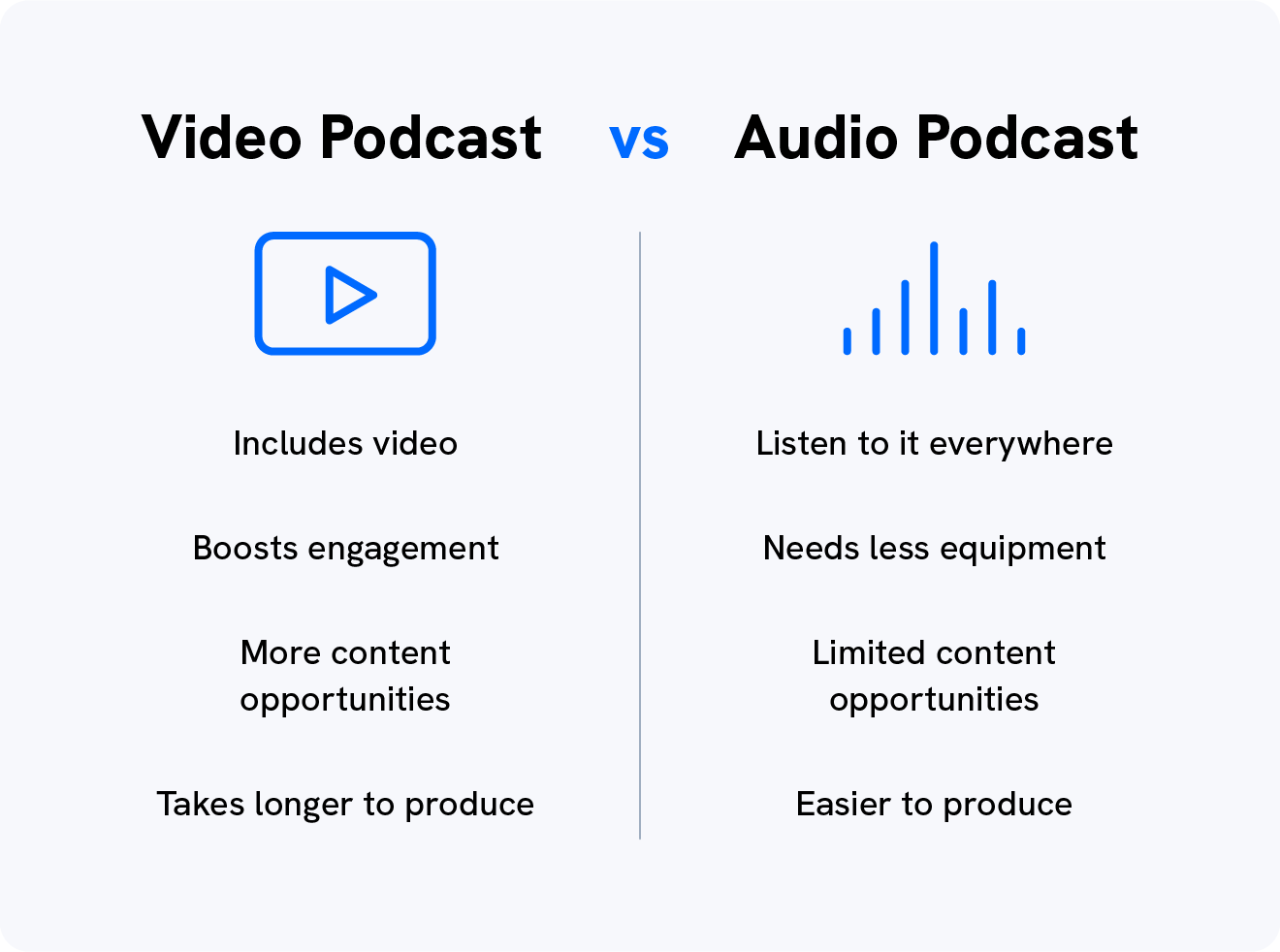
There are a couple of advantages and disadvantages to each as well.
With audio podcasting, people have the convenience of listening to it everywhere they go while doing different activities. All they need is their ears, after all.
Audio podcasts also can be a little easier to produce since you’re only recording the audio — which also means you can record it in your pajamas.
But, since it’s only audio, podcasters miss out on including visuals that could help paint a better picture of the story being told and feel limited to only talking about things that they can explain through audio.
Video podcasting, on the other hand, can keep viewers fully engaged by giving them context for everything in the audio.
It also gives creators the possibility to expand their content and share things visually, such as reacting to a video or showing a product.
However, video podcasting can be more difficult to produce and require more equipment and time. Viewers will also be limited to when and where they can watch your podcast.
Why Do You Need to Start Video Podcasting?
If you want to start a video podcast but are wondering if it’s worth it, there are a couple of reasons you should go for it.
Some of the benefits of video podcasting include:
- Access to a wider audience: with video, you get access to a larger group of consumers including those who prefer audio-only content and those who prefer video content.
- Visual appeal: people like to see your face and this helps you build a deeper connection with them. They want to see who they’re listening to, your expressions, or anything you’re showing.
- Shareability: video is a big part of social media, and it can be a lot easier to promote your podcast that way and get viewers to share it.
- Repurposing: you’ll be able to cut out snippets of your video podcast to share on social media and deliver it in different ways. Plus, they have a chance of going viral.
You’re also doing most of the work already.
Adding a visual element to your podcasts will feel easier over time, especially if you have your content planned out.
Types of Video Podcasts
Before jumping into how to begin a video podcast, you need to know the different types of video podcasts.
Choosing the right type of video podcast can help you deliver content that’s aligned with your brand and content goals.
But it’s also important to pick a format that makes you feel the most comfortable and delivers your content the right way. So consider the recording space, the equipment, and software you have access to.
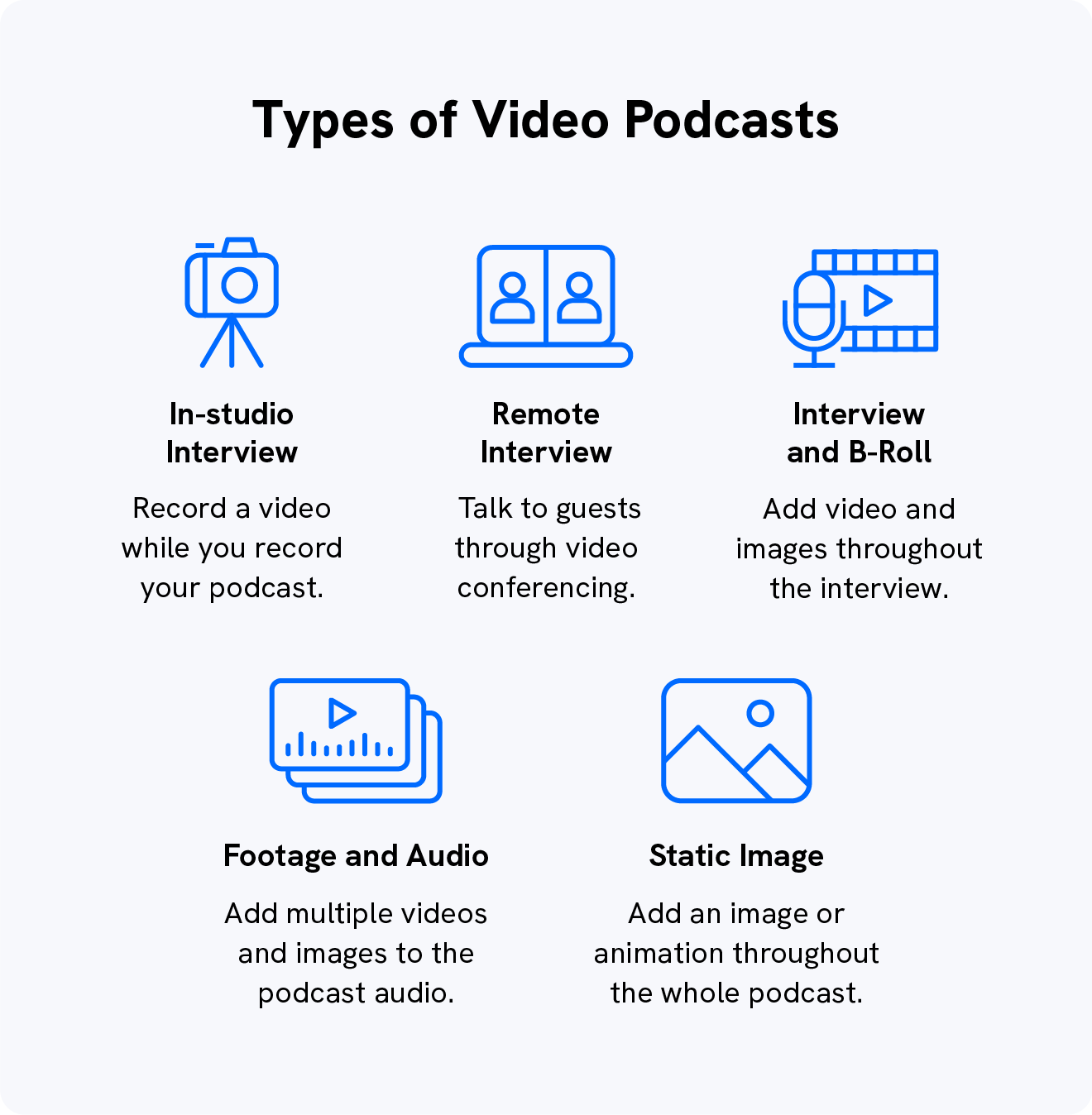
Whether you’re comfortable in front of the camera or prefer filming b-roll footage, there’s a type of video podcast for you.
In-Studio Recording
In-studio recording is when you record your conversation with your guests in a studio or podcast room.
This is a great type of video podcast since you can show everyone’s reactions and gestures during the conversation, as well as make your viewers feel more connected to your content.
In-studio video podcasts work great if you have a designated space to record your videos.
This way, you can set up a camera to record the whole conversation, which you can later promote on social media.
Proper in-studio recording of your podcast will require you to have a couple of cameras set up so you can get a view of each speaker.
It also will take a bit longer to produce since you will have to set up your studio and edit the video.
However, it’s an easy video podcast option since you’re recording the video along with your conversation.
💡How They Do It
A good example of remote interview video podcasting is The Video Entrepreneur Podcast, a podcast with video experts, creators, and entrepreneurs.
They do a great job of splitting the screen between both speakers during the conversation while also bringing focus to only one of the screens when they are speaking.
Remote Interview Recording
Interviewing someone from across the country (or world)? We’re sure it would be great to fly them over to meet you, but there’s a less-expensive workaround.
With remote interview recording, you video-record yourself and ask your guests to record themselves during your conversation.
And you can even make things even more simple by using a tool to record every webcam at the same time, like Zoom.
This is a great way to make video podcasts more engaging even if you and your guests are far apart. Plus, you will only need a couple of tools and some equipment to do it.
However, if the internet connection is poor, you could end up with choppy shots or lagging audio.
💡How They Do It
A good example of remote interview video podcasting is The Video Entrepreneur Podcast, which is a podcast with video experts, creators, and entrepreneurs.
They do a great job of splitting the screen between both speakers during the conversation while also bringing focus to only one of the screens when they are speaking.
Interview and B-Roll Recording
An interview and b-roll recording podcast is more of a documentary-style video, where you add b-roll footage to your video interview to keep viewers even more engaged.
The interview and b-roll video podcast is great because it lets you engage with the viewers even more by bringing an outside visual reference to what you talk about.
It works great if you’re talking about a more technical topic where you can show examples or even if you’re reacting to a video.
And if you enjoy telling stories on your podcasts, this is the perfect way to help your viewers visualize the story better by creating b-roll footage of certain scenes.
This podcast type will take more work to produce, since you’ll have to edit the b-roll footage into the video and make sure the audio is synchronized.
💡How They Do It
The podcast, Murder With My Husband, does a great job at using the interview and b-roll format. They include photos and videos through the murder stories so viewers can understand the story better and who they are talking about.
Their podcast channel on YouTube has over 140,000 subscribers and over 7 million total views.
Footage and Audio
Footage and audio podcasts are great if you would rather stay off-camera while engaging viewers with video.
This format uses videos, stock footage, animations, or video content to illustrate what is said on the podcast.
With these, you can create short videos that go along with the episode or create your animation style to make the story more engaging.
You can also create animated highlights of snippets of your podcast, to grow your audience and drive them to watch the full episode.
However, this type of podcast will take some effort, since you’ll need to create or source footage to add to your podcast and edit everything together.
💡How They Do It
The podcasts Kid’s Explore and StoryCorps are both great examples of podcasts that use video content and audio to bring the podcast episode to life.
They use animations and other visual elements to complement the podcast’s story, which makes it more engaging for kids.
Static Image Recording
An easy way to add a video element to your video podcast is by using a static image, which is great if you have less time on your hands to produce it.
For this type of video podcast, you simply add an image that will stay on the screen while your podcast is being played.
This image can be…
- your logo
- an animation
- a digital artwork
- a photo that represents your topic
…or you can use the podcast cover as the static image.
Although this type of video podcast is less engaging, it’s still a good way to help people share and post it on different platforms, such as YouTube.
💡How They Do It
ARTE is a French radio podcast that shares episodes on YouTube with photos and sometimes text translations in English for viewers.
How to Start a Video Podcast in 9 Steps
If you’re ready to start making your podcast more engaging with videos, there are a couple of steps to follow to make sure you’re creating the best video podcast for your audience.
We’ll let you in on our secrets on how to start video podcasting and how to keep it professional and engaging.
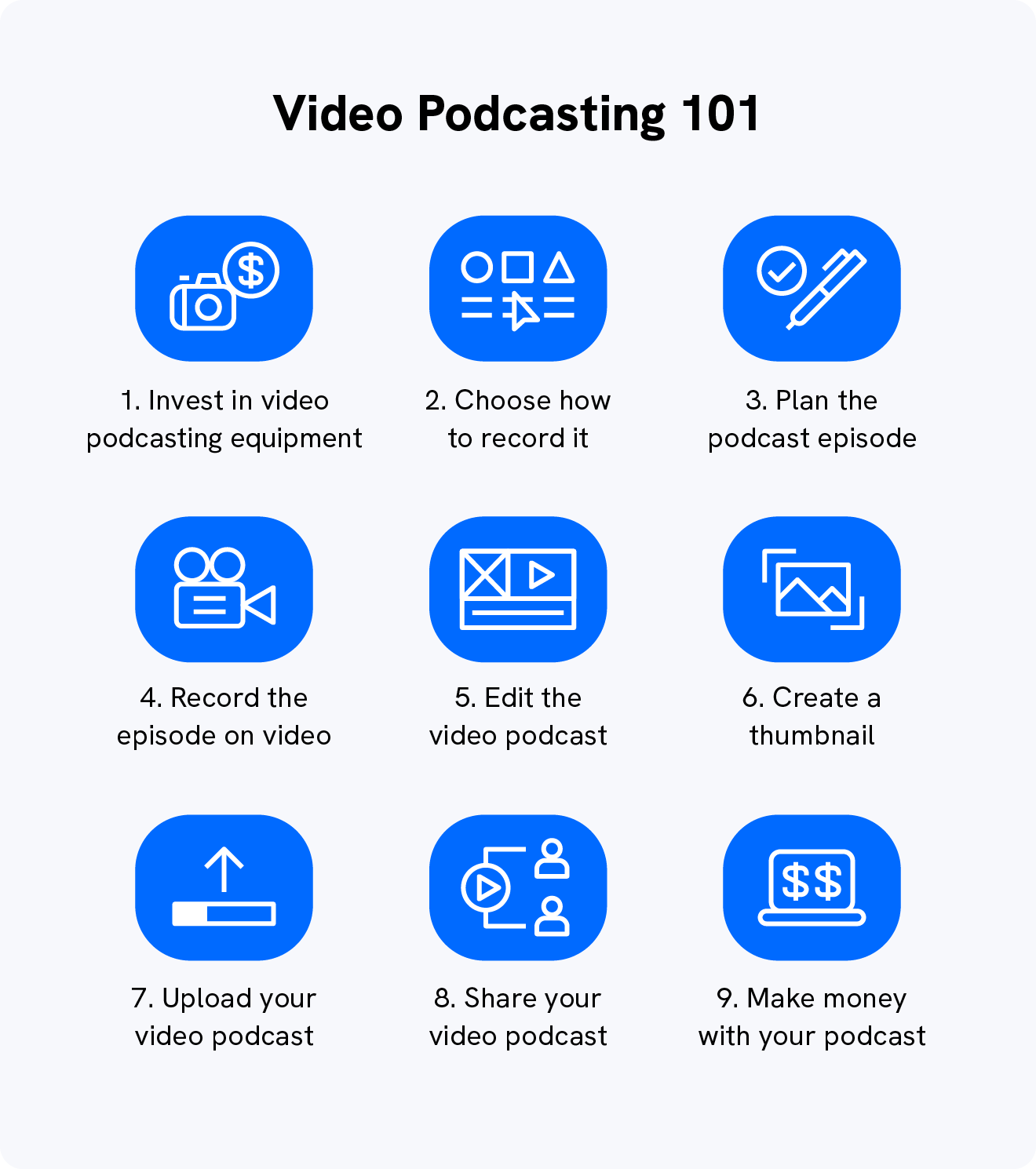
Let’s do this.
1. Invest in Video Podcasting Equipment
Having a high-quality podcast starts with the right equipment.
So what do you need to make a video podcast?
You can start video podcasting with just a few tools and equipment, even with a low budget.
The main video podcasting equipment you’ll need is…
- a camera
- some microphones
- a tripod
- podcast software
…but you can also invest in more equipment such as more cameras, lights, and headphones.
Depending on the video podcast type you choose, you will also need good video editing software and animation tools, as well as software that allows you to record remote interviews.
2. Choose How to Record It
Now it’s time to choose the type of podcast you’ll record.
The podcast type you choose will depend on the content you’ll be delivering, what your audience prefers, and what you feel the most comfortable with.
When choosing what video podcast type is right for you, consider asking yourself:
- How much time do I want to spend creating a podcast episode?
- Do I need to show images or videos throughout the podcast?
- Do I have a space set up for recording that will look good on camera?
- Do I want to bring guests to my podcast?
- How much should I invest in podcast equipment?
It’s also a good idea to engage with your audience and ask them what format of video podcast they would prefer to watch.
Once you gather all of this information, you’ll be able to choose the right type of video podcast.
You can also try out a couple of different types to see which fits your content the best and adjust if you need to.
3. Plan the Podcast Episode
Although a lot of podcasts tend to be more loose and spontaneous, it’s always good to plan the content of your episode ahead of time.
Whether you want to create a video script for your podcast or just a rough outline, you should decide on a couple of things:
- The length of your episode.
- The topic of the episode.
- Talking points.
- Questions to ask the guest.
- Video assets or props.
You can also plan a couple of your episodes ahead of time so your podcast episodes can follow a theme or a chronological order.
If you’re inviting guests, make sure to brief them about the topic and questions and guide them through using the equipment to make sure you get the highest-quality content.
4. Record the Episode on Video
After planning your episode and getting everything ready, it’s now time to press the record button.
Our tips for recording your video podcast differ depending on the type of video podcast you choose.
- Static image recording: choose the image you’ll be showing and make sure the audio is clear.
- In-studio recording: make sure all the equipment is recording, the lighting is good, and everyone is in the shot.
- Remote interview recording: check if the internet connection is good and make sure you’re recording through the video conferencing software.
- Interview and b-roll recording: plan which shots you will have to add to the recording and record your video podcast.
- Footage and audio recording: make sure your footage matches your podcast audio.
Since video podcasts tend to be more spontaneous and cut-free, make sure all cameras are in the right position, fully charged, and that everything is ready to go.
But most of all, have fun while recording, and remember to keep engaging your viewers by encouraging them to subscribe or submit questions for you to answer.
5. Edit the Video Podcast
Once your podcast recording is wrapped up and ready to shine, it’s time to piece together the audio and video.
If you’re looking for beginner video editing software we recommend using:
- Adobe Premiere
- Corel VideoStudio
- Filmora 9
- Final Cut Pro
- iMovie
Recording your podcast audio with an external microphone ensures you have the best audio quality, so make sure to sync the video and the sound so they match perfectly.
This helps when you add elements like images, video, and animation. You can also add your podcast introduction and fun effects or edits.
Video editing software also lets you adjust the color of your video and cut any excess shots.
6. Create a Thumbnail
Creating a good thumbnail for your podcast is a great way to attract more viewers, especially if you’re sharing it on a competitive platform like YouTube.
You should include in your thumbnail:
- Your podcast logo.
- Your guests’ names.
- An interesting shot of the podcast.
- The title or topic of the podcast.
This way, your video podcast will have the right cover so people know what to expect from your content and will feel encouraged to click on it.
If you’re sharing a snippet from your podcast on social media, you can also create a personalized thumbnail with the right dimensions.
7. Upload Your Video Podcast
We’re almost at the finish line!
Once you’re done editing your podcast, it’s time to upload it to the podcast platform of your choice.
Upload your podcast to all of your preferred podcast platforms, including Spotify, Apple Podcasts, and Google Podcasts.
But also upload them to your video platforms such as YouTube.
The great thing about a video podcast is that you can still upload the audio version to an audio-only podcast platform, allowing you to reach an entirely different audience.
8. Share Your Video Podcast
Now it’s time to get the word out there about your new podcast episode.
Share the link to your episode across all of your social media platforms and remind your followers when your next episodes will be released.
But repurposing is where your video podcast really shines: You can share more than just the link to your podcast.
Grab short highlights from your podcast to share as a TikTok, a Reel on Instagram, or YouTube Short.
This way, people will be able to watch a snippet of your podcast and will want to continue watching the full episode.
It also makes it easier for people to share these short snippets of your podcasts, which will bring you a new audience and more views.
An example of this is the Jumpers Jump podcast, which became super popular after posting funny snippets of their podcast on TikTok, which brought more people to watch the full episodes.
You can also create a YouTube channel with your podcast highlights that piece together a couple of the best moments of your podcast, similar to TMG Podcast Highlights.
9. Monetize Your Video Podcast
But did you know you can also make money with your podcasts?
Take advantage of all of the hard work it took to create your video podcast, and monetize it.
A lot of people make money with sponsorships and advertising on their podcasts. They’ll have short breaks where they recommend a product or mention the sponsor of the podcast at the beginning.
You can monetize your video podcasts by:
- Using affiliate marketing include links to products you mention in your podcast and get a small percentage from the purchases.
- Creating premium content: launch exclusive podcasts and content where people have to pay to access it.
- Launch digital products: sell online courses, coaching services, and eBooks related to your podcast.
- Sell podcast merch: create your own podcast merch, such as shirts and mugs. Use and advertise them during your podcasts.
You can also share your podcast mainly on your video-on-demand platform, so people can pay a monthly fee to access your podcasts and other exclusive content.
Want to learn more about video podcasts? Pore over our infographic with a step-by-step guide.

Wrapping It Up
Are you ready to start video podcasting?
With our tips, you’ll be ready to shine behind the microphone and in front of the cameras.
And if you’re looking to make money with your video podcast through a video-on-demand platform, Uscreen is the way to go.
We hope to see (and hear) from you soon!
Build, launch and manage your membership, all in one place.
Video Podcasting FAQs
People like video podcasts are much like reality TV. They offer viewers a glimpse at the lives and ideas of people they consider influential. People get to tune into podcasts about topics they’re interested in, making the experience more personal.
Video podcasting differs from audio podcasting in that you can view a video while listening to the podcast. Audio podcasts are simple audio recordings.
You should consider video podcasting if you’d like to expand your audience reach with a new form of content. Video is more appealing because it is visual, and many people like to watch content whether at home, the office, or on the go using their mobile phones.
Video podcasts work by recording podcast episodes with a camera, using editing software to polish the footage, and then publishing it on several platforms for viewers to enjoy.
Video podcasts should be as long or short as your subject for an episode requires. Podcasts in general are conversations, and the best conversations are unscripted, interesting, and filled with valuable information. Aim to offer the same in yours and you’ll find that the length of your podcast episodes becomes just what they need to be.
There are 5 popular video podcast formats and styles. These include:
In-Studio Interviews: Record a video while you record your podcast.
Remote Interview: RTalke to guests through video conferencing.
Interview and B-Roll: Add video and images throughout the interview.
Footage and Audio: Add multiple videos and images to the podcast audio.
Static Image: Add an image or animation throughout the whole podcast.
A drawback of using a video podcast for creators is the amount of work they require to produce each episode. Video recordings require editing which can take hours and days.
There are various ways to distribute your video podcasting, including:
Social media platforms: Upload your episodes to each site. Consider using Facebook, Instagram, X (Twitter), Pinterest, Tumblr, Reddit, LinkedIn, WeChat, and even WhatsApp if you have a group.
Video On-Demand (VOD) Platforms: Create channels or pages and share your content there. Popular VOD platforms to share your content on include YouTube, Vimeo, and Spotify.
Email: Send subscribers an email broadcast whenever you release a new episode.
You don’t need to have professional video editing skills to produce a video podcast. As a beginner, you can use intuitive software like Adobe Premiere, Corel VideoStudio, Filmora 9, iMovie, and Final Cut Pro to build your skills and experience.
Yes, you can convert your existing audio podcast into a video podcast. Use the B-roll footage, or add animations or still images that show as audio plays.
